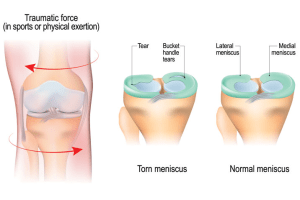Knee Meniscus Injuries: Symptoms and Treatment Options
The knee joint is composed of bones, ligaments, tendons, and cartilage. The knee meniscus is a C-shaped piece of cartilage that acts as a shock absorber. They help stabilize the thigh bone (femur) and the shinbone (tibia) in the knee joint. Each knee contains a lateral and medial meniscus. A meniscus tear is a common knee injury that can occur as a result of sudden twisting or rotating movements.

Symptoms of Meniscus Injuries:
The symptoms of a meniscus injury can vary depending on the severity. Some common symptoms of a meniscus tear include:
- Pain: Pain is the most common symptom of a meniscus tear. It is usually felt along the joint line and can be sharp or dull.
- Swelling: Swelling around the knee joint is another common symptom of a meniscus tear. The knee may appear swollen and feel stiff or tight.
- Locking or catching: If a piece of the torn meniscus gets caught in the knee joint, it can cause the knee to lock or catch, making it difficult to straighten or bend the knee.
- Clicking or popping: A meniscus tear can also cause a clicking or popping sensation in the knee joint, especially when bending or straightening the knee.
Treatment Options for Meniscus Injuries:
The treatment options for a meniscus tear depend on the severity of the injury and the patient’s age and activity level. Some common treatment options for a meniscus tear include:
- Rest, Ice and Compression: Resting the knee and applying ice or a compression bandage to the affected area can help reduce swelling and pain.
- Physical Therapy: A physical therapist can help patients with meniscus injuries regain strength and range of motion in the knee joint through exercises and stretching.
- Knee Braces: A knee brace can help support the knee joint in the short term, although if symptoms persist the brace is not going to make your knee any stronger.
- Surgery: In some cases, surgery may be necessary to repair or remove the torn meniscus.
 Exercises for Meniscus Injuries:
Exercises for Meniscus Injuries:
The following exercises can help with meniscus injury early on
- Straight Leg Raise: Lie on your back with your injured leg straight and your other leg bent. Tighten your thigh muscles and lift your injured leg about 6 inches off the ground. Hold for a count of 5 and then slowly lower your leg. Repeat 10 times.
- Wall Squats: Stand with your back against a wall and your feet shoulder-width apart. Slide down the wall, bending your knees until they are around a 90-degree angle. Hold for a count of 5-10s and then slowly slide back up the wall. Repeat 10 times.
- Hamstring Bridge: Lie on your back with knees bent and feet flat on the floor. Flex your feet so only the heels touch. Press down through your heels slowly lifting your hips from the ground as high as comfortable and lower down slowly. Repeat 10 times.
Small amounts of pain during exercises can be expected, but reduce the load/reps or cease an exercise altogether if the pain increases significantly.
In conclusion, a meniscus tear is a common knee injury that can cause pain, swelling, and stiffness or catching in the knee joint. Physical therapy and exercises can help with meniscus injuries by reducing pain, increasing strength, and improving range of motion in the knee joint. The above exercises are simple and effective examples to begin recovery from a meniscus injury.
To find our more head to this news article: https://www.straitstimes.com/singapore/health/hip-and-knee-orthopaedics-treating-knee-pain-meniscus-tear-
If you suspect you have had a meniscus injury, see us at Physico City Physiotherapy to guide you through assessment and treatment of your injured knee! https://www.physicocityphysio.com.au/bookings/

